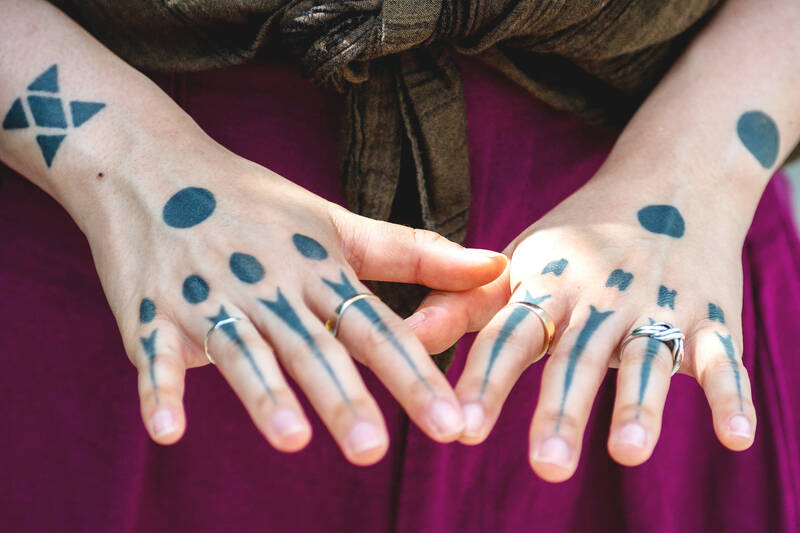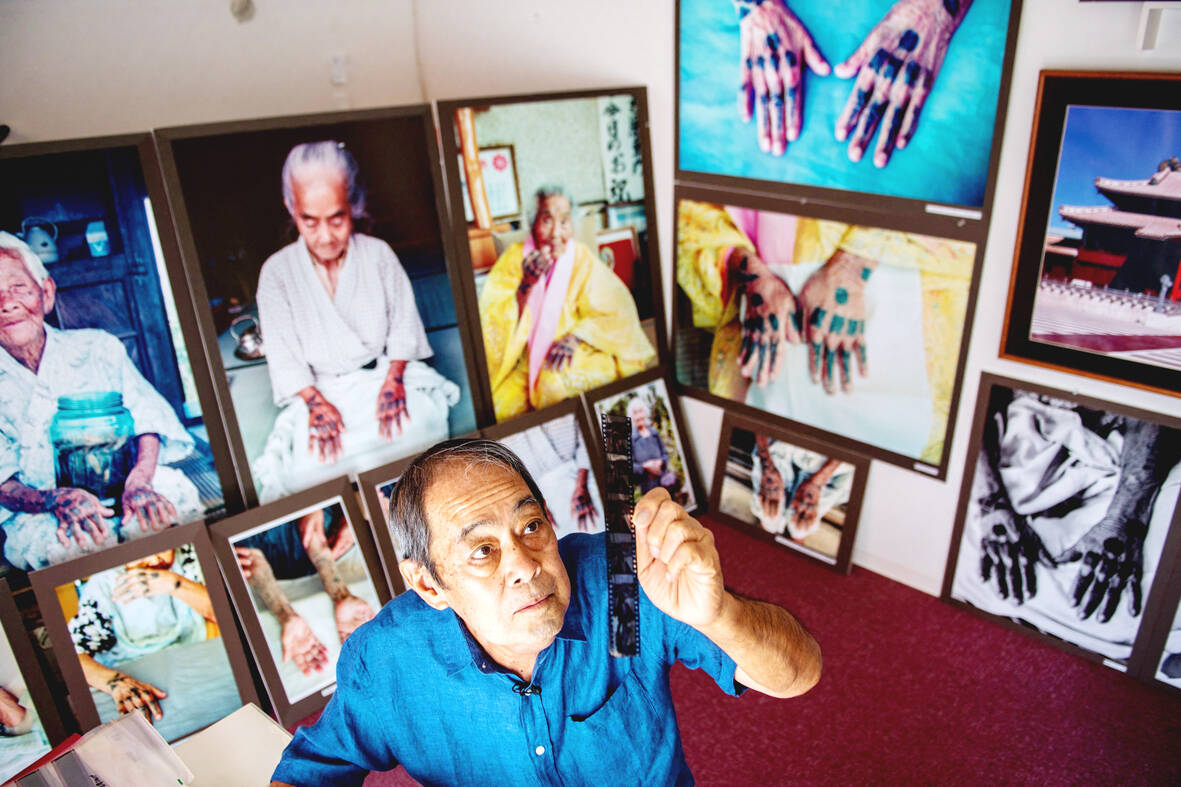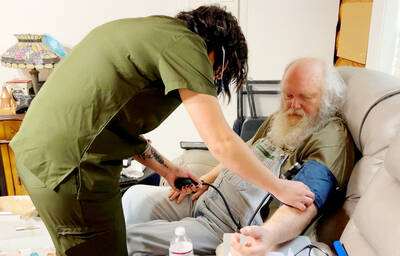Moeko Heshiki is no ordinary tattoo artist: she is one of the few people keeping the once-banned tradition of hajichi body art alive for the indigenous Ryukyu people of Japan’s Okinawa region. The traditionally hand-poked markings were once common on women of the Ryukyu, who lived throughout the southern islands of what is now Japan.
The monochrome patterns, ranging from delicate arrow-like symbols to arrays of large dots, marked important moments in a woman’s life and, in some cases, were believed to ensure passage to heaven.
When Japan annexed the Okinawa island chain in 1879, however, a process of forced assimilation set the hajichi tradition on the path to extinction.

Photo: AFP
In mainland Japan, tattoos were associated with illegal behavior, because criminals were sometimes tattooed by authorities to mark them out.
“Those with hajichi were fined and discriminated against,” 30-year-old Heshiki said in Naha, Okinawa’s main city. “(The body art) was degraded as tattoos, rather than understood as hajichi.”
A ban on the markings was lifted after World War II, but the practice did not resume, and as women with hajichi passed away, the culture seemed destined to die out.

Photo: AFP
Heshiki, born to a father from Okinawa and a mother from Japan’s main island Honshu, stumbled across hajichi while researching possible tattoos.
“I was dying to have them on me,” she said. After a tattooist specializing in tribal work inked her, she felt “more connected to myself, or to Okinawa.”
“I felt I had finally become my true self.”
She wears hajichi shaped like arrows on the tops of all her fingers, dots and geometric patterns on the backs of her hands and larger versions around her wrists.
Today, she works as a “hajicha,” reproducing the traditional designs on clients who connect with her through Instagram.
While tattoos are still often frowned upon in Japanese society, younger generations are increasingly open to body art.
But Heshiki thinks hajichi should not become just another fad.
She offers traditional patterns to those with roots in Okinawa and takes time to discuss the markings and meanings with clients beforehand, researching designs in books about the art. Hajichi was traditionally applied with a bamboo stick and ink made from charcoal and the Okinawan liquor awamori. Heshiki hand pokes the designs, but with regular needles and ink.
One of the best-known documenters of hajichi is Hiroaki Yamashiro, who photographed dozens of elderly women with the body art from 1970 onwards.
A native of Okinawa’s Miyakojima, the 73-year-old began the project almost by accident as a student, when he spotted an elderly lady as he scouted for subjects.
“She had hajichi, and a very graceful look,” he said.
He photographed around 30 women with hajichi until 1990, including a 107-year-old who still remembered the pain of having the markings done.
“She had to put her swollen hands in a bucket of soybean pulp left over from making tofu to cool them.”
Yamashiro welcomes the revival of hajichi but believes it should not be watered down to a mere fashion statement.
“This is a culture only practiced by Ryukyu women, it’s something completely different from tattoos.”
He hopes younger generations will be “even more proud” of being Okinawan, and “retain the Okinawan culture, way of thinking and identity.”

President William Lai (賴清德) has championed Taiwan as an “AI Island” — an artificial intelligence (AI) hub powering the global tech economy. But without major shifts in talent, funding and strategic direction, this vision risks becoming a static fortress: indispensable, yet immobile and vulnerable. It’s time to reframe Taiwan’s ambition. Time to move from a resource-rich AI island to an AI Armada. Why change metaphors? Because choosing the right metaphor shapes both understanding and strategy. The “AI Island” frames our national ambition as a static fortress that, while valuable, is still vulnerable and reactive. Shifting our metaphor to an “AI Armada”

When Taiwan was battered by storms this summer, the only crumb of comfort I could take was knowing that some advice I’d drafted several weeks earlier had been correct. Regarding the Southern Cross-Island Highway (南橫公路), a spectacular high-elevation route connecting Taiwan’s southwest with the country’s southeast, I’d written: “The precarious existence of this road cannot be overstated; those hoping to drive or ride all the way across should have a backup plan.” As this article was going to press, the middle section of the highway, between Meishankou (梅山口) in Kaohsiung and Siangyang (向陽) in Taitung County, was still closed to outsiders

The older you get, and the more obsessed with your health, the more it feels as if life comes down to numbers: how many more years you can expect; your lean body mass; your percentage of visceral fat; how dense your bones are; how many kilos you can squat; how long you can deadhang; how often you still do it; your levels of LDL and HDL cholesterol; your resting heart rate; your overnight blood oxygen level; how quickly you can run; how many steps you do in a day; how many hours you sleep; how fast you are shrinking; how

“‘Medicine and civilization’ were two of the main themes that the Japanese colonial government repeatedly used to persuade Taiwanese to accept colonization,” wrote academic Liu Shi-yung (劉士永) in a chapter on public health under the Japanese. The new government led by Goto Shimpei viewed Taiwan and the Taiwanese as unsanitary, sources of infection and disease, in need of a civilized hand. Taiwan’s location in the tropics was emphasized, making it an exotic site distant from Japan, requiring the introduction of modern ideas of governance and disease control. The Japanese made great progress in battling disease. Malaria was reduced. Dengue was